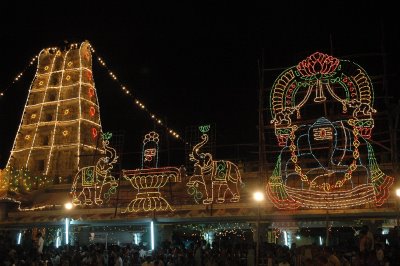Kanipakam is a small village on the bank of Bahuda River. Kani" means wetland and "Pakam" means flow of water into wetland. According to the legend of the temple there were three brothers and each one had a handicap. Viz., Dumb, Deaf and Blind. They were earning out their livelihood by cultivating a small piece of land.
In olden days water was drawn from the well by way of 'Piccota System'. As one of them used to irrigate the field through the channels, the other two used to ply on the Piccota. On one such operation they found that the water in the well got dried up and they could no longer continue their job. One of them got into the well and started digging it up. He was taken aback to see the iron implement hitting a stone like formation.
Later, he was shocked to see blood oozing out from it. Within in a few seconds the entire water in the well, turned blood red in colour. Thus, startled by this divine sight, all the three became normal getting rid of their deformities. As soon as the villagers came to know about this miracle, they thronged to the well and tried to deepen the well further. But their attempt proved futile because the 'swayambhu' idol (the self-manifested) of Lord Vinayaka emerged from the swirling waters.
Ultimately they offered many number of coconuts with all prayers- modesty kneeling before the new idol afford "MAGALHARATHI" etc. They declared the ideal of "SWAYAMBHU" and tendered number of coconuts. The coconuts water flowed into the channel to a distance of more than one and a quarter acres. The indication of this led to the modification in the usage of the Tamil word "KANIPARAKAM" and later pronounced as KANIPAKAM. Even today the idol is in the original well and the springs of the well are perennial and the eternal. During the rainy season, the holy water from the well overflows even today.
Another striking and strange feature of the idol is that it is still growing in size. At present, we can see the knees and the abdomen of the idol. Smt. Lakshmamma, an ardent devotee had offered a 'Kavacham' (Armour) to the Lord, fifty years ago but today it is out of size and doesn't fit the idol. The holy water from the well is offered to the devotees as theertham.
The legend behind Bahuda River
Long ago there lived two brothers Sankha and Likhita. They were on a pilgrimage to Kanipakam. As the journey was tiring, the younger brother Likhita felt hungry. Disregarding the advice of the elder brother he plucked a mango from the mango grove. Sankha felt bad and reported this to the ruler of that area and pleaded for punishment for the sin committed during the pilgrimage. Thus Likhita was punished severely being deprived of both arms.
Later they took bath in the river near Kanipakam temple. Lo Behold! The chopped arms were restored to Likhita as soon as he had a dip in the sacred waters of the river. These incidents lead the ruler to rename the river as 'Bahuda' (Bahu means human arm). Thus the river beside Kanipakam temple is now known as 'Bahuda River'.
Sri Varasiddhi Vinayaka as up-holder of 'Truth'
The swayambhu idol of Kanipakam is the up-holder of truth. Day to day disputes between people is resolved by taking a 'special oath'. The people in the dispute take a holy dip in the temple tank and swear before the lord. It is taken as gospel truth.
There are instances when the person who committed that sin voluntarily agrees as soon as he had the dip and much before entering the temple itself. It seems the Lord lawns invisibly on the sinner and makes him repent & feel guilty for his sinful deeds.
Thus the glory of Sri Varasiddhi Vinayaka spread far and wide and the honorable courts uphold the 'special oath' in their judicial pronouncements.